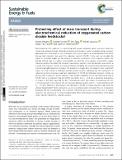Protecting effect of mass transport during electrochemical reduction of oxygenated carbon dioxide feedstocks
Author(s)
Williams, Kindle; Corbin, Nathan; Zeng, Joy; Lazouski, Nikifar; Yang, Deng-Tao; Manthiram, Karthish; ... Show more Show less
Downloadc9se00024k.pdf (771.3Kb)
Publisher with Creative Commons License
Publisher with Creative Commons License
Creative Commons Attribution
Terms of use
Metadata
Show full item recordAbstract
Electrochemical CO₂ reduction is a promising path toward mitigating carbon emissions while also monetizing waste gas through chemicals production and storage of surplus renewable energy. However, deploying such a technology for use on industrial CO₂ sources requires an understanding of the effects that gas feed impurities have upon CO₂ reduction reaction (CO₂RR). In this work, we elucidate the impact of molecular oxygen on the network of reactions occurring in a CO₂ reduction system. Our findings indicate that for a planar, polycrystalline Au electrode in an aqueous environment, oxygen reduction current is limited by the transport characteristics specific to the cell geometry and solvent; as a result, mass transport confers a protective effect by mitigating the otherwise thermodynamically and kinetically favorable reduction of oxygen. The presence of oxygen does not appear to have a significant impact on either CO₂RR or hydrogen evolution partial currents, indicating that the mechanisms of reduction reactions involving oxygen are independent of CO₂RR and hydrogen evolution. Further, an electrokinetic mechanistic analysis indicates many feasible candidates for the rate-determining step of CO₂RR; there is no indication that the CO₂RR mechanism at P[subscript CO₂] = 0.5 atm is altered by the presence of oxygen, as the Tafel slopes (59 mV dec⁻¹) and reaction orders with respect to bicarbonate (0), CO₂ (∼1.5), and protons (0 from lack of KIE) are consistent between systems with P[subscript O₂] = 0 atm and those with P[subscript O₂] = 0.5 atm. While this is promising for the robustness of CO₂RR to oxygen impurities in gas feeds, the ultimate design tradeoff when utilizing CO₂ sources containing oxygen is between the cost of separation processes and the corresponding cost of power inefficiency as a result of electrons lost to oxygen reduction. This represents a first step in understanding kinetic and transport considerations in the design of gas-impurity-tolerant CO₂ reduction systems.
Date issued
2019-03Department
Massachusetts Institute of Technology. Department of Chemical EngineeringJournal
Sustainable Energy & Fuels
Publisher
Royal Society of Chemistry (RSC)
Citation
Williams, Kindle et al. "Protecting effect of mass transport during electrochemical reduction of oxygenated carbon dioxide feedstocks." Sustainable Energy & Fuels 3, 5 (March 2019): 1225-1232 © 2019 Royal Society of Chemistry
Version: Final published version
ISSN
2398-4902